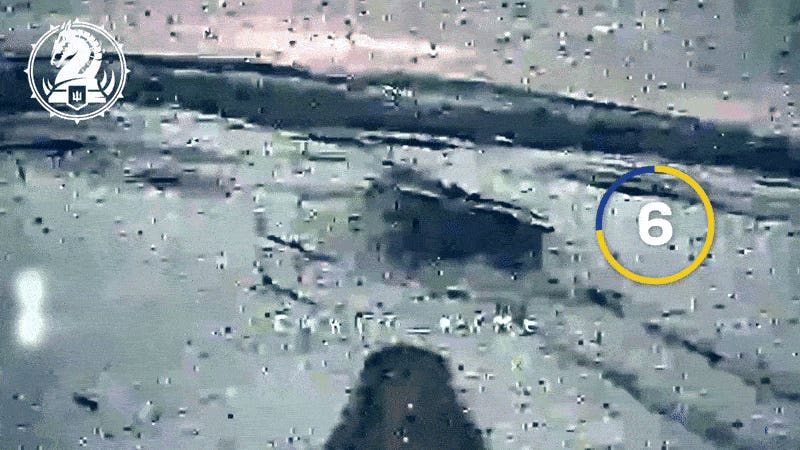A solitary Russian turtle tank almost reached Ukrainian lines in western Russia’s Kursk Oblast on or just before Sunday.
Rolling right through a minefield, shrugging off six mine blasts, the up-armored vehicle—wearing a shed-like layer of metal sheeting to help protect it from drones—raced across the no-man’s-land on the western side of the 250-square-mile, Ukrainian-held salient.
But then the vehicle’s own armor apparently doomed it. The driver, their vision likely obscured by the add-on metal plates, didn’t notice the deep hole—a possible shell crater—in the tank’s path. As a surveillance drone from the Ukrainian 47th Mechanized Brigade watched, the Russian vehicle tipped into the hole.
An explosive first-person-view drone immediately slammed into the stuck tank. One Russian managed to climb out of the vehicle—but collapsed in the snow a short distance away.
Ukrainian troops warned this kind of thing might happen. In one close inspection of a T-62 turtle tank the Ukrainian 22nd Mechanized Brigade captured along with its two crew last year, Lt. Col. Serhiy Misyura listed the vehicle’s flaws. “The driver has almost no visibility,” Misyura warned.
The turtle tank’s “fatal trip,” as the 47th Mechanized Brigade described it, was one of countless such incidents as Russia’s wider war on Ukraine grinds into its fourth year. Russian forces are actually losing ground in Kursk, but they’re managing to slowly advance in several sectors of front in eastern Ukraine.
But at staggering cost. In total, the Russians have lost more than 15,500 vehicles and other pieces of heavy equipment—twice what the Ukrainians have lost.
Total Russian casualties since February 2022 could be close to 800,000. Ukrainian losses since early 2022 are much lower: 43,000 killed and 370,000 injured, Ukrainian Pres. Volodymyr Zelensky said in December. In the best-defended sectors, the Ukrainians kill seven Russians for every Ukrainian soldier the Russians kill, one Russian defector claimed.
Drones are among the biggest killers on both sides. But the Ukrainians deploy more drones—2.2 million last year, according to Zelensky—and enjoy greater freedom of flight as widespread Ukrainian jamming grounds all but the best Russian drones: the radio-free fiber-optic models.
Ukraine’s drone superiority is the main reason Zelensky can reject, and so far has rejected, attempts by the increasingly Russia-aligned administration of U.S. Pres. Donald Trump to force Ukraine into an unfavorable ceasefire while also extorting the war-torn country for hundreds of billions of dollars worth of rare minerals.
But Ukrainian drone coverage is uneven and fragile in places. Many Ukrainian teams depend on Starlink satellite terminals to connect them to their drones. But Starlink is largely owned by rightwing billionaire Elon Musk, a top Trump donor and a major purveyor of Russian propaganda. After Zelensky rejected the mineral extortion, the United States reportedly threatened to cut off Starlik access for Ukrainian forces.
Fortunately for Ukraine, Polish officials intervened, reminding the Americans that Poland pays for much of Ukraine’s Starlink services on the basis of commercial contracts.
There are other vulnerabilities in the Ukrainian drone system. At least one drone team in Kursk has run out of the infrared sensor equipped “vampire” drones that the Ukrainians use to harass Russian positions and supply lines at night. “We really just don’t have night drones anymore and it’s very important,” operator Kriegsforscher wrote.
At the same time, Zelensky claimed Ukraine would further ramp up drone production, possibly implying any current shortages are temporary. “This year, we will make more,” he said. And that could make it even harder and costlier for Russian troops to advance.
Read the full article here





